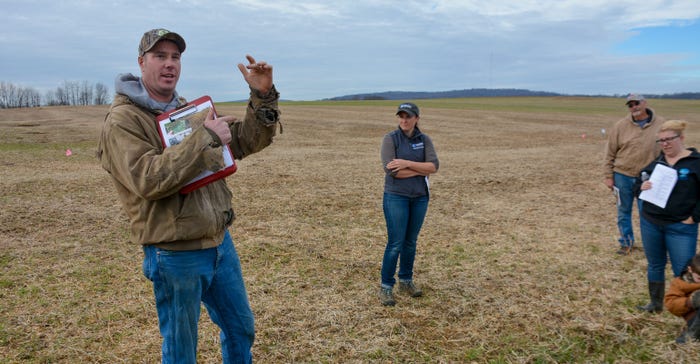
Getting cover crops established in fall can be difficult, especially if a farmer is trying to get one on after a late fall crop.
Andy Flinchbaugh, who’s a partner in his family farming business just outside York, Pa., has been broadcasting cereal rye after his fall crops for several years with good success.
But rye loves nitrogen, and this makes it a challenge to use before corn, another nitrogen-loving crop.
So, Flinchbaugh had an idea: What if he could get a legume in with the cereal rye or another cover crop to preserve more nitrogen for the following corn? And it could be done in a double-crop soybean system?
The Keystone Chapter of the Soil and Water Conservation Society is funding a demonstration plot to answer Flinchbaugh’s questions.
Heidi Reid, Penn State Extension agronomist in York County, says that getting a cover crop in prior to winter is important since this is when soil is at its most vulnerable for erosion. Double-crop soybeans are challenging, she says, because of their late harvest, making it challenging to get a winter cover in the ground.
Broadcasting the seed
Even though drilling is often the best way to get a uniform stand, Reid and Flinchbaugh broadcasted the cover crops into standing double-crop soybeans.
Five seeding plots were broadcast on Oct. 11 using a fertilizer spreader: wheat, wheat and crimson clover, wheat and hairy vetch, crimson clover, and hairy vetch.
The soybeans, a group 3.7 Pioneer 37T51, were harvested Nov. 9.
Walking the plots
About two-dozen farmers showed up to Flinchbaugh’s farm on the day before Thanksgiving to check out the plots.
There wasn’t much to see. Establishment was hard to find and was spotty at best.
Using a homemade square, Reid measured plant density getting 10 random samples in each plot.
The plots with the standalone crops weren’t impressive. The crimson clover and hairy vetch had only five plants per square foot. The wheat plots had only seven plants per square foot.
The plots with the mixes, though, did much better with the wheat and crimson clover, and wheat and hairy vetch each with 12 plants per square foot. To get the maximum benefits from cover crops you need at least 11 plants per square foot, she says, referring to prior research from the USDA’s Natural Resources Conservation Service.
Challenges to establishment
Broadcasting was a little later than Flinchbaugh would’ve liked, adding that he could have gone earlier in October or even in late September, but dryer-than-normal weather made it difficult to do.
It was dry when the plots were planted. Reid plotted rainfall events after planting and only two storms — Oct. 17 and Oct. 28 — produced rainfall over 1 inch. Other rainfall events in October produced only a half-inch. Broadcasting seed prior to a good rainfall is important since this will help the seeds infiltrate into the ground and get establishment going.
But there was another unexpected challenge. Reid says she noticed feeding from Mexican bean beetles on the soybean leaves when she planted the cover crop plots. Nearly a month later when she came to do a plot check, she found even more Mexican bean beetles, this time feeding on the crimson clover and decimating the crop.
“It turns out they really like crimson clover,” she says.
Mexican bean beetles are found in many areas of the Midwest and East where they overwinter as adults in soybean refuse in fields or in woodlands adjoining fields. Adults can defoliate soybean plants, but larvae are more destructive.
Lots of potential, plenty of questions
Overwintering legumes can provide a good amount of nitrogen for the following spring crop.
According to a chart Reid provided, crimson clover planted at 25 pounds per acre has a potential nitrogen provision of between 70 and 130 pounds per acre. Hairy vetch, planted at 50 pounds per acre, can provide between 80 and 160 pounds per acre of N.
But they are costly to plant. Crimson clover costs about $1.40 per pound while hairy vetch costs around $2.40 a pound. So, it must pay for a farmer to use either one of these legumes in a rotation, especially if corn is the spring crop.
 LOOKING FOR ANSWERS: Andy Flinchbaugh and Heidi Reid are looking at legume cover crops after double-crop soybeans to preserve more nitrogen for the following corn crop.
LOOKING FOR ANSWERS: Andy Flinchbaugh and Heidi Reid are looking at legume cover crops after double-crop soybeans to preserve more nitrogen for the following corn crop.

“It’s really the N provision” that gets farmers interested, Reid says, and it’s up to an individual farmer to see if it pays in the long run.
Flinchbaugh notes that the 50-pound rate of hairy vetch is higher than what he would normally do — 30 pounds is normal, especially if you’re planting on a large scale. He says that he bought the 50-pound bags and “threw the whole bag in.”
Another challenge, he says, is loss of soybeans from broadcasting seed. He estimates that he lost between 3% and 5% of his soybeans due to driving them down, so that’s a cost that also must be considered.
"We need to do something that's cost-effective, and we can get this done on 90% of our acres. That’s how we're going to make a difference in the water-quality challenges that we're up against," Flinchbaugh says.
About the Author(s)
You May Also Like






